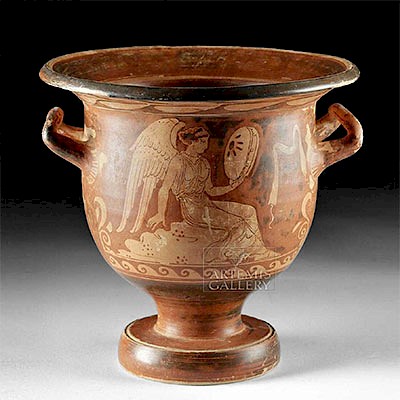Luristan Bronze Sword - Double Ear Pommel
Lot 109
About Seller
Artemis Gallery
686 S Taylor Ave, Ste 106
Louisville, CO 80027
United States
Selling antiquities, ancient and ethnographic art online since 1993, Artemis Gallery specializes in Classical Antiquities (Egyptian, Greek, Roman, Near Eastern), Asian, Pre-Columbian, African / Tribal / Oceanographic art. Our extensive inventory includes pottery, stone, metal, wood, glass and textil...Read more
Estimate:
$2,000 - $3,000
Absentee vs Live bid
Two ways to bid:
- Leave a max absentee bid and the platform will bid on your behalf up to your maximum bid during the live auction.
- Bid live during the auction and your bids will be submitted real-time to the auctioneer.
Bid Increments
| Price | Bid Increment |
|---|---|
| $0 | $25 |
| $300 | $50 |
| $1,000 | $100 |
| $2,000 | $250 |
| $5,000 | $500 |
| $10,000 | $1,000 |
| $20,000 | $2,500 |
| $50,000 | $5,000 |
| $100,000 | $10,000 |
| $200,000 | $20,000 |
About Auction
By Artemis Gallery
Mar 7, 2019
Set Reminder
2019-03-07 10:00:00
2019-03-07 10:00:00
America/New_York
Bidsquare
Bidsquare : VARIETY SALE | Antiquities & Ethnographic Art
https://www.bidsquare.com/auctions/artemis-gallery/variety-sale-antiquities-ethnographic-art-3928
Around the world & back in time - be amazed at the treasures you will find. Antiquities from Egypt, Greece, Italy and the Near East, Asian, Pre-Columbian, African / Tribal / Oceanic, Native American, Spanish Colonial, Russian Icons, Fine Art, much more! Artemis Gallery info@artemisgallery.com
Around the world & back in time - be amazed at the treasures you will find. Antiquities from Egypt, Greece, Italy and the Near East, Asian, Pre-Columbian, African / Tribal / Oceanic, Native American, Spanish Colonial, Russian Icons, Fine Art, much more! Artemis Gallery info@artemisgallery.com
- Lot Description
Ancient Near East, Luristan, ca. 1200 to 800 BCE. A good example of a classic Central Asian form, a bronze sword of the "double ear" pommel style, made by highly trained artisans using the lost wax casting technique. The blade was cast first, and then the handle was cast onto it. This well-balanced weapon has a slender, cuboid hilt that was once wrapped with leather, bone, or ivory; this is of a piece with a pommel that divides into two finely decorated semi-circular "ears" at right angles to the blade. The rectangular guard has an almost zoomorphic form with two horn-like projections, one on each side, that extend down to firmly grip the upper end of the blade. A wide, flat midrib flows from the guard to the tip, tapering reguluarly with the almost straight cutting edge of the blade to a point. Size: 19.5" L x 2.5" W (49.5 cm x 6.4 cm)
It seems that swords like this were not just made to be used in battle, but instead to show status or as votive weapons to be deposited in hoards. There is a strong tradition in the ancient Near East of swords and other weapons being associated with the gods. For example, there is a rock carving dating to ca. 1300 BCE from this region that shows a scene of the gods of the Underworld, including one who is holding a sword similar to this one. Similarly, a golden bowl excavated at Hasanlu shows three swords of similar form to this one that are associated with three deities from the Hittite pantheon. Whatever its original function, this would have been a spectacular weapon to behold, with a deep, shining surface when polished. Whoever commissioned this sword must have been a high status individual, perhaps seeking to honor their gods by handling such a weapon.
Provenance: private J. Connell collection, Massachusetts, USA
All items legal to buy/sell under U.S. Statute covering cultural patrimony Code 2600, CHAPTER 14, and are guaranteed to be as described or your money back.
A Certificate of Authenticity will accompany all winning bids.
We ship worldwide and handle all shipping in-house for your convenience.
#127388Edges of blade have small areas of loss/corrosion, especially along the tip. Mottled patina, with light encrustation. Slight bending to form of pommel.Condition
- Shipping Info
-
All shipping is handled in-house for your convenience. Your invoice from Artemis Gallery will include shipping calculation instructions. If in doubt, please inquire BEFORE bidding for estimated shipping costs for individual items.
-
- Buyer's Premium



 EUR
EUR CAD
CAD AUD
AUD GBP
GBP MXN
MXN HKD
HKD CNY
CNY MYR
MYR SEK
SEK SGD
SGD CHF
CHF THB
THB














